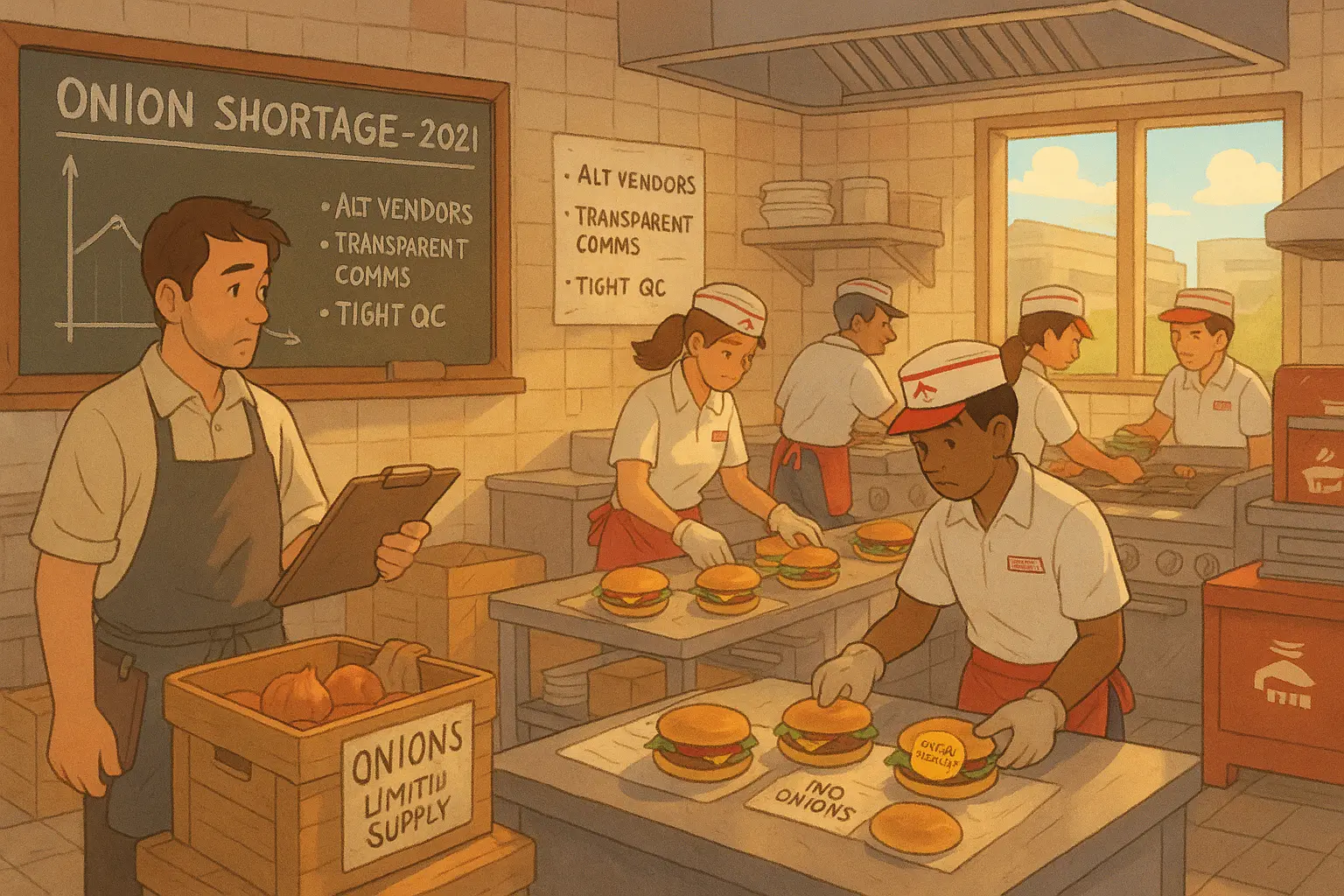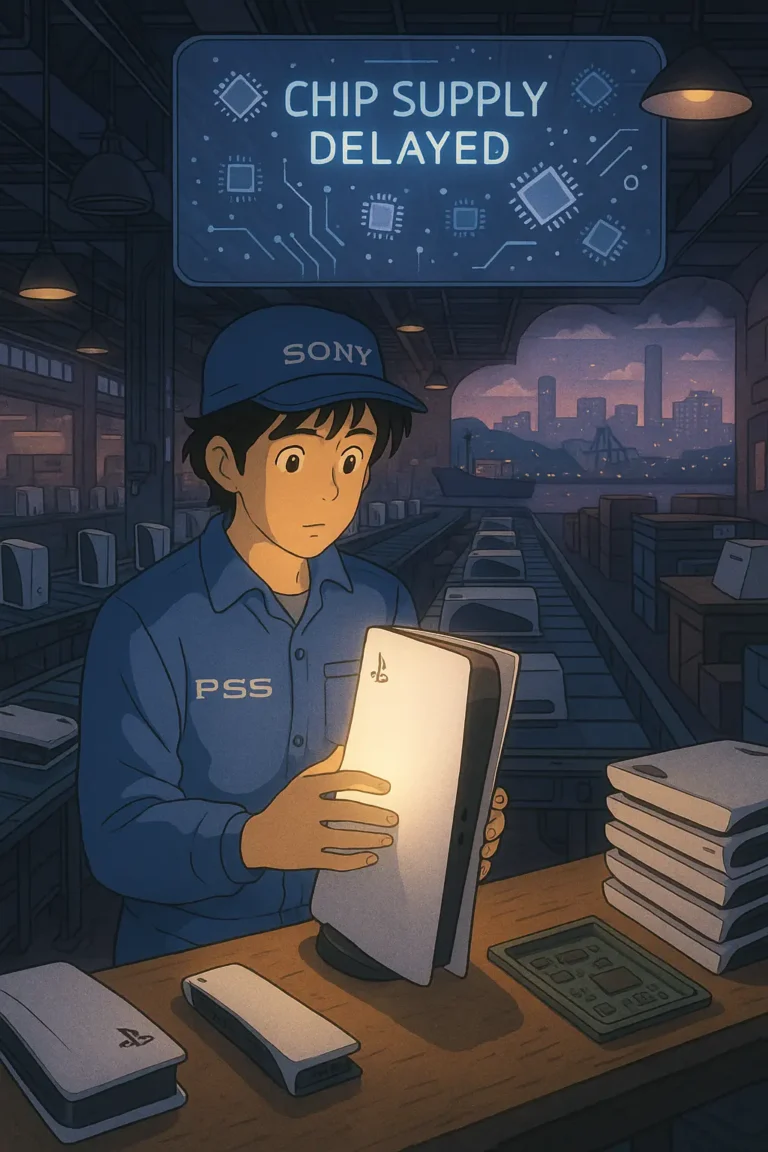
The 2021 In-N-Out onion shortage tested the company’s supply chain, which is often praised for its simplicity and quality control. But the outcome proved that the supply chain was much stronger and more flexible than people thought.
Article Brief & Key Nuggets
- In-N-Out’s onion shortage in 2021 started with weather and crop failures in California, the chain’s key onion source.
- The shortage threatened the restaurant’s ability to meet customer expectations due to its fresh-only, no-freezer model.
- In response, In-N-Out repurposed other onion types, rationed use, and sourced quickly from new farms.
- Onion supply was restored within a week through agile sourcing and fast transport tactics.
- The episode offers concrete lessons in sourcing flexibility, risk mapping, and empowering local decisions, essential for supply chain resilience, including across African markets.
A Minor Ingredient, A Major Disruption
The In-N-Out restaurant chain is famous for its fresh-only, no-freezer model. And it works for the company. However, a crop failure in California forced the fast-food chain to improvise quickly.
With no backup inventory and no freezers, the onion shortage threatened to unravel the supply chain’s ability to deliver the exact meal customers were expecting. And that inability to get the onions from partner farmers threatened to unravel the entire process.
The good news for the company is that the fix came quickly, but it wasn’t just a matter of luck. It was the result of smart logistics and supply chain management, even under pressure. However, to achieve this, certain things had to be in place before the crisis occurred.
Why The In-N-Out’s Onion Shortage Happened
California faced extreme heat and a never-ending drought in 2021. As a result, fewer acres were planted compared to the previous years, which meant the yields were lower compared to those of previous years. Ultimately, that year, a failed onion harvest occurred in California.
Overall, there was a 5% decline in onion output nationwide, but California saw the brunt of it, and In-N-Out was directly in the line of fire. Onion shortages aren’t rare. However, In-N-Out’s supply chain setup exacerbated this particular case.
To keep onions fresh in its meals, the restaurant chain does not freeze or hoard its onion supplies; instead, In-N-Out relies on daily fresh deliveries. However, the company’s ingredient list for its menu is short, and onions play a significant role.
That means if an onion goes missing, it is felt immediately in every meal, especially its famed burger. Behind the scenes, the available onions weren’t moving fast enough.
In-N-Out’s supply chain also had to contend with delays caused by trucking bottlenecks and labor shortages, which added pressure. At the time, it felt like a looming service failure because the company had no onion buffer.
Read more: How Shoprite Holdings’ Supply Chain Disruptions Forced Its Exit From Nigeria.
In-N-Out’s Supply Chain Pressure: Operational Impact
Onion seems like an inconsequential ingredient, so why was In-N-Out’s supply chain under a lot of pressure?
Here’s what was at risk for the company:
- Menu Integrity: Onions weren’t a side item; they’re part of the core product.
- Operational Rhythm: Daily fresh delivery routines are tight. Any shift ripples through the system.
- Customer Experience: Long-time customers expect the same burger every visit. And they were going to catch even the slightest change.
Without onions, In-N-Out stores had two choices: serve incomplete products or stop service altogether. Neither was acceptable, so a workaround had to be implemented.
In-N-Out’s Supply Chain Response: Quick Thinking on the Floor and in the Chain
In-N-Out’s supply chain responded with a mix of fast logistics and local improvisation.
1. Repurposing In-House Supply
Restaurants under the In-N-Out brand began slicing up whole onions meant for onion rings. These weren’t the usual burger onions, but they were usable. This pivot enabled store teams to continue serving full products, even with slight changes in appearance or flavor.
It wasn’t perfect, but it was fast. And it gave restaurants a way to meet customers’ demands, even if only partially.
2. Onion Rationing
Where supplies were lower, managers limited portions or made onions available only by request. This way, the company was able to reduce waste and stretch the supply across more customers. This kind of partial pullback is common during shortages.
Experts refer to it as “portion control under pressure.” If done correctly, it can give customers what they want while maintaining product consistency and reducing strain on stock.
3. New Suppliers, Same Standards
In-N-Out’s supply chain team reached out to farms in states like New Mexico and Arizona. The states are close to California, and the growers there were starting their own harvest around that time. The timing was perfect, and their onions filled the gap left by California’s shortfall.
This is typical supply chain agility in motion: switching sources before customers notice a problem.
4. Rapid Logistics Rerouting
In-N-Out’s supply chain brought in onions from farther away — outside the usual regional radius. That meant reorganizing trucking routes and pushing faster shipping schedules. Since the company controls its own distribution centers, it could do this quickly.
There were no lengthy approval chains and no bureaucratic red tape. This agility restored normal supply levels within about a week. Although the disruption was real, the customer experience remained largely intact.
Read more: Timeless Lessons From Dell’s Build-to-Order Strategy in The 2000s.
What In-N-Out’s Onion Shortage Story Reveals About Strong Supply Chains
Every part of In-N-Out’s response teaches a lesson.
1. Single-Sourcing Failures Are Real Risks
There are many raw materials that seem minor, but in reality, they really aren’t. One small missing item can stop the entire flow in systems built for precision. Fast food chains, airlines, and manufacturing lines face the same threat.
The solution here is to identify single points of failure and take steps to ensure an adequate backup is in place. If one component can break the system, build a backup now.
2. Supply Chains Must Be Built for Swaps
In-N-Out couldn’t predict that the California harvest would collapse. But it had access to alternative options. Growers with whom they had established relationships, making it easier to ensure customers do not notice the problem.
The team knew where else onions grew, and who could deliver on short notice.
This strategy is crucial in today’s market, which is characterized by numerous disruptions. To stay flexible, establish relationships with alternate suppliers. That way, when a problem arises, the supply chain can rely on them.
Diversify your sourcing regions. Build second-tier supplier relationships even when primary ones are stable.
3. Flexibility Beats Forecasts in a Crisis
Not everything is predictable. But resilience means being able to respond fast. In-N-Out rerouted logistics, prioritized onions in truckloads, and let local teams adjust serving sizes. These weren’t central policies — they were fast tactical moves.
To enjoy the same type of flexibility, create supply systems with adjustable lanes. Let local teams react without waiting for top-down approval.
4. Quiet Fixes Work Better Than Loud Explanations
Customers never saw a massive PR campaign about the shortage. That’s because most stores still had onions, even if they were sliced differently or in smaller quantities. By acting early, the chain avoided disruption, having no real impact on the customer experience.
Set up your supply chain to ensure an early response, respond promptly, and minimize the impact on customers. Most supply issues can be fixed before they become service issues, but only if teams act early.
Read more: How Caterpillar’s Supply Chain Playbook Beat The 2014-2016 Downturn.
From California to Nairobi: What African Supply Chains Must Learn
The In-N-Out onion shortage wasn’t about a lack of onions. It was about readiness. That same readiness is needed across African food and logistics systems, where droughts, poor roads, and import dependency create similar threats.
1. Don’t Over-Rely on One Supplier or One Region
Many African businesses source fresh produce from a single area or a single supplier. And it can be tempting to do the same. For example, when you find a really good supplier, you do not want to go through the stress of dealing with other not-so-reliable suppliers.
Or in some cases, go through the rigorous process of finding another when the one you have works so well for your supply chain. However, there is a problem with this type of sourcing.
When faced with a challenge, whether it stems from poor infrastructure, security concerns, or a political crisis, even the best suppliers and regions can be affected. This is why it is vital to identify alternative sourcing and build contracts, even if it comes with additional costs.
Risk is more expensive than price.
2. Shorten the Chain, Then Build Redundancy
Local sourcing can help. But it must be tied to backup transport, supplier rotations, and emergency delivery networks. To get started, invest in local logistics solutions and regional warehousing that allows you to tap into the local market with ease.
Also invest in supply chain tech that alerts you when the input volumes drop.
The Real Value Is in What Didn’t Happen
Customers continued to come, and the press didn’t explode because, despite the challenges, burgers were never not available for customers. That’s the real win in the In-N-Out supply chain story. What matters most in logistics isn’t how smoothly things run when everything’s fine.
It’s how quiet your fix is when things break.
Every chain faces a shortage eventually. How you react is the difference between a bad day and a lost customer. So map your risks, source wider, and let the people closest to the problem take the first swing at solving it. That’s how a broken supply line doesn’t break your brand.

Obinabo Tochukwu Tabansi is a supply chain digital writer (Content writer & Ghostwriter) helping professionals and business owners across Africa learn from real-world supply chain wins and setbacks and apply proven strategies to their own operations. He also crafts social content for logistics and supply chain companies, turning their solutions and insights into engaging posts that drive visibility and trust.







